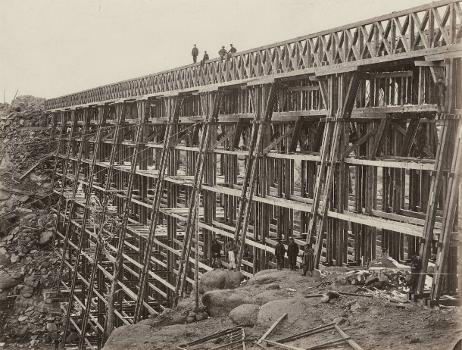General Information
| Other name(s): | Great Iron Bridge; Dale Creek Bridge |
|---|---|
| Beginning of works: | 1867 |
| Completion: | 1869 |
| Status: | demolished (1886) |
Project Type
| Structure: |
Trestle bridge |
|---|---|
| Function / usage: |
Railroad (railway) bridge |
| Material: |
Steel bridge Structurae Plus/Pro - Subscribe Now! |
Awards and Distinctions
| 1986 |
for registered users |
|---|
Location
| Location: |
Albany County, Wyoming, USA |
|---|---|
| Coordinates: | 41° 6' 13.70" N 105° 27' 17.20" W |
Technical Information
Dimensions
| height above valley floor or water | 45.7 m |
Materials
| deck |
steel
|
|---|---|
| piers |
steel
|
| foundations |
masonry
|
Excerpt from Wikipedia
The 650-foot (200 m) Dale Creek Crossing, completed in 1868 in southeastern Wyoming Territory, presented engineers of the United States' first transcontinental railroad one of their most difficult challenges. Dale Creek Bridge, the longest bridge on the Union Pacific Railroad (UP), reached 150 feet (46 m) above Dale Creek, two miles (3.2 km) west of Sherman, Wyoming. The eastern approach to the bridge site, near the highest elevation on the UP, 8,247 feet (2,514 m) above sea level, required cutting through granite for nearly a mile. Solid rock also confronted workers on the west side of the bridge where they made a cut one mile (1.6 km) in length.
Originally built of wood, the trestle swayed in the wind as the first train crossed on April 23, 1868. In the days following, as carpenters rushed to shore up the bridge, two fell to their deaths. Still, the bridge's timbers flexed under the strain of passing trains.
The original Dale Creek wooden bridge under construction, Harper's Weekly, 1868
The original bridge was replaced on the 1868 piers in 1876 by an iron bridge, manufactured by the American Bridge Company. The wooden approaches at each end remained in place when the iron bridge was built. The western approach caught fire in 1884, and was repaired. The UP installed girder spans and granite abutments to strengthen the bridge in 1885. Engineers installed guy wires on both the wooden bridge and its iron replacement in an attempt to stabilize the structures.
"Standing on its tall, spindly iron legs that looked as sturdy as knitting needles, it was the highest and most dangerous crossing on the line. Engineers had to slow the train to 4 mph (6 km/h), or a stiff Wyoming wind would push empty boxcars into the rocky gap."
The replacement iron "spider web" bridge, in turn, was dismantled in 1901, when the Union Pacific completed construction of a new alignment over Sherman Hill as part of a major reconstruction and improvement project, shortening the Overland Route by 30.47 miles (49 km).
Text imported from Wikipedia article "Dale Creek Crossing" and modified on November 4, 2021 according to the CC-BY-SA 4.0 International license.
Participants
Currently there is no information available about persons or companies having participated in this project.
Relevant Web Sites
Relevant Publications
- (2002): Bridges that Changed the World. Prestel, Munich (Germany), pp. 8.
- (2002): Brücken, die die Welt verbinden. Prestel, Munich (Germany), pp. 8.
- About this
data sheet - Structure-ID
20005528 - Published on:
27/09/2002 - Last updated on:
31/10/2021





